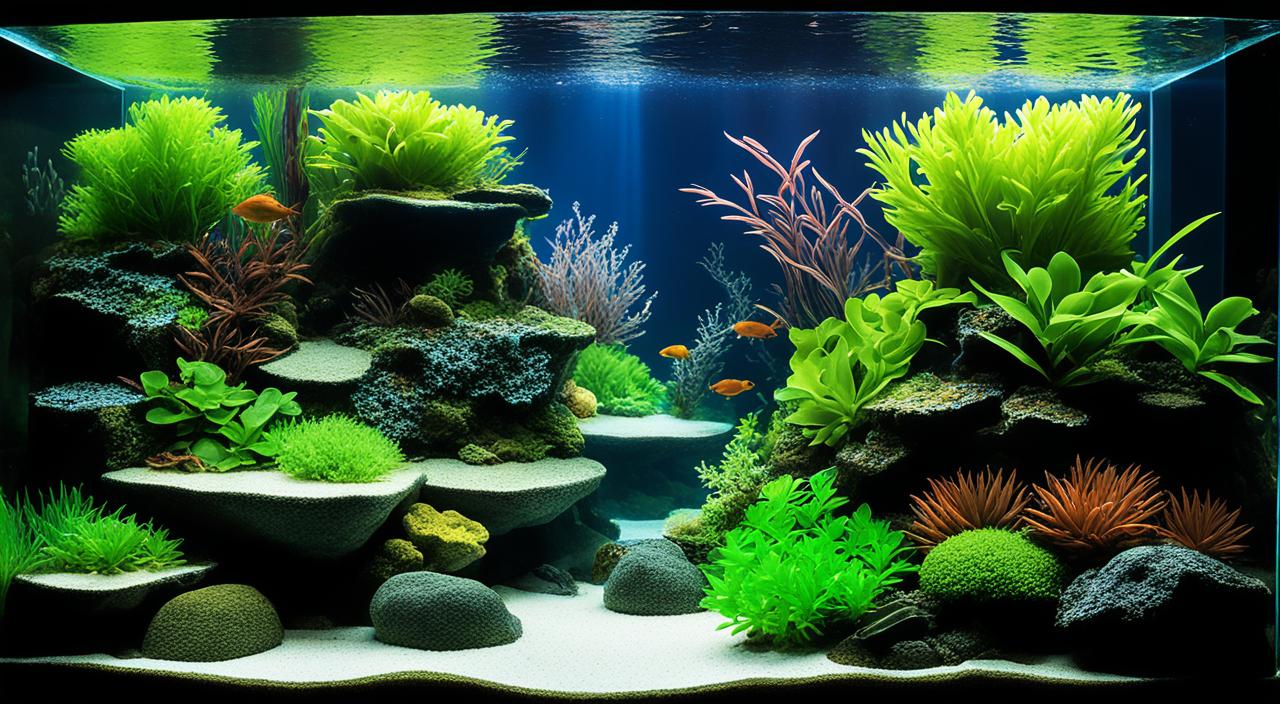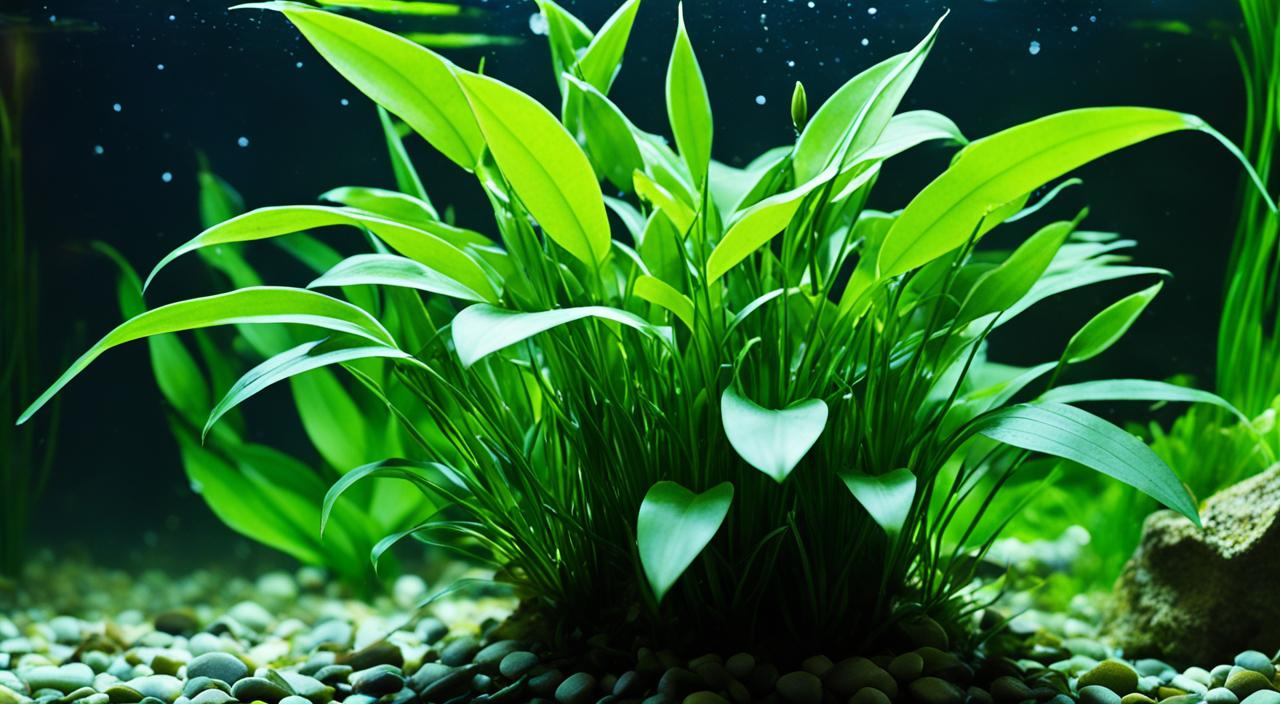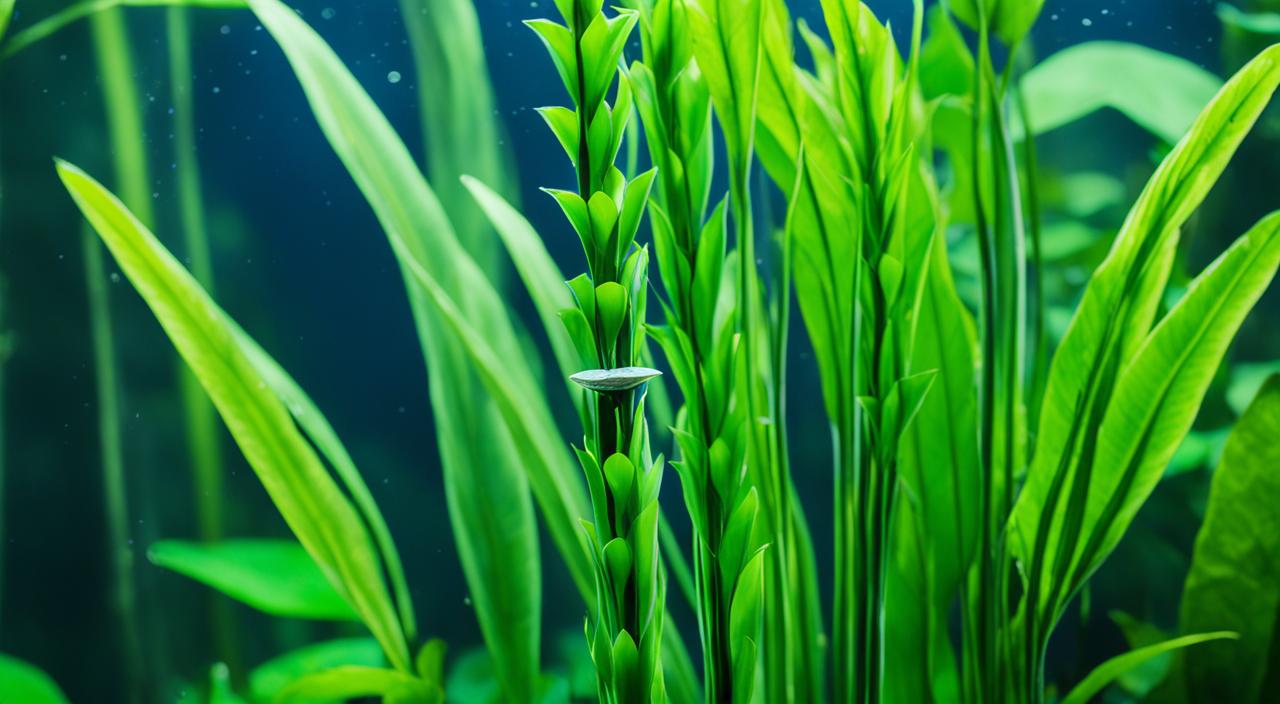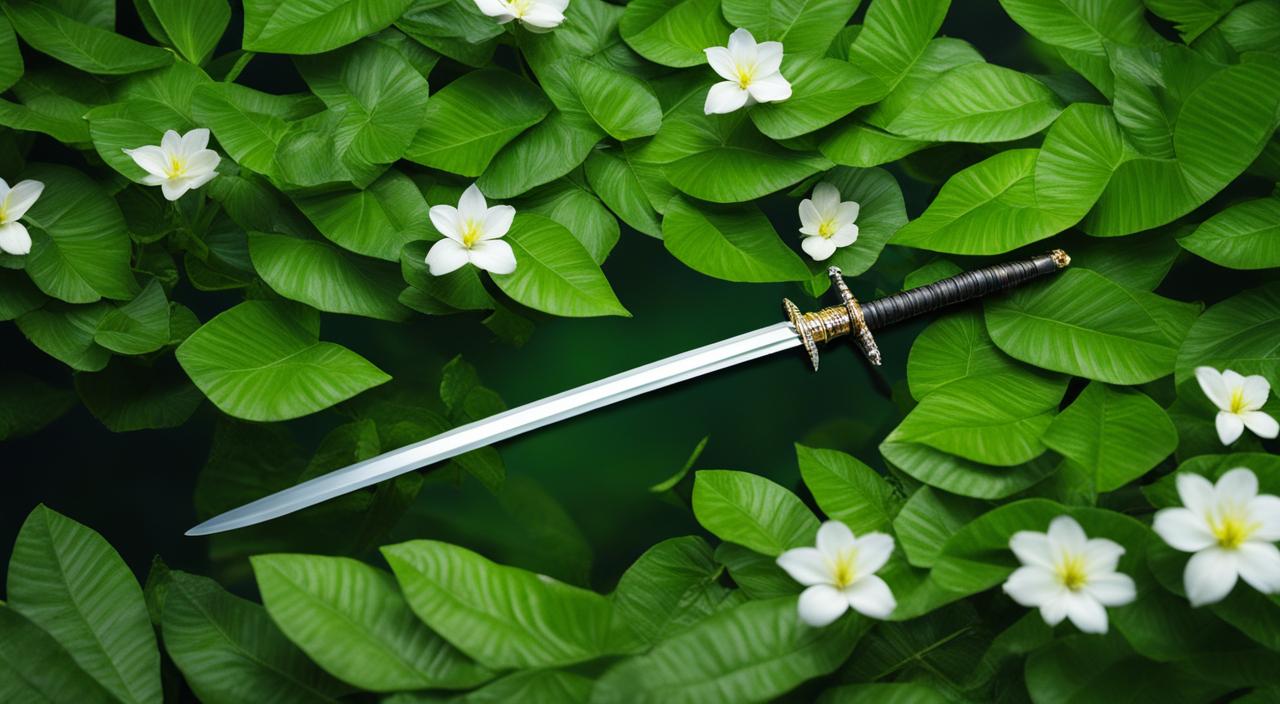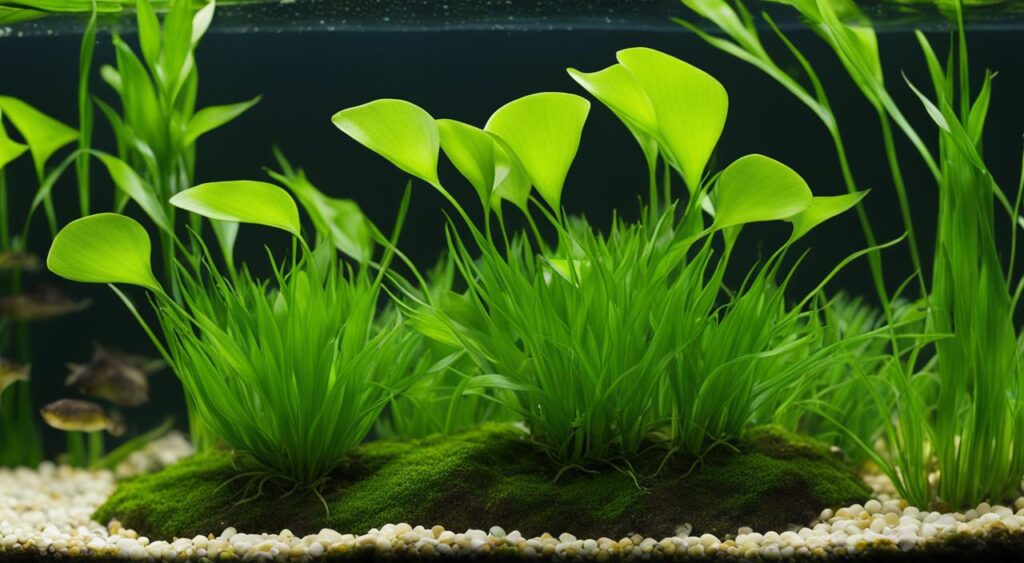
This section will explore the fascinating world of Dwarf Sagittaria, also known as Sagittaria subulata. We will discover the critical details about its care requirements, planting techniques, and more. Whether you are a beginner or an experienced aquarist, this article will provide expert tips and insights on successfully cultivating this beautiful aquatic plant in your freshwater aquarium.
Key Takeaways:
- Learn essential care requirements for growing Dwarf Sagittaria in your freshwater aquarium.
- Discover expert tips on planting techniques and propagation methods.
- Explore the ideal habitat conditions and water parameters for this aquatic plant.
- Uncover the aesthetic benefits and aquascaping possibilities with Dwarf Sagittaria.
- Identify common challenges and solutions to maintain a thriving Dwarf Sagittaria in your aquarium.
Introduction
This section will overview Dwarf Sagittaria, discussing its characteristics and why it is popular among aquarium enthusiasts. We will delve into its growth habits, visual appeal, and unique features, making it an excellent addition to any aquascape.
| Description | Dwarf Sagittaria (Sagittaria subulata) Details |
|---|---|
| Scientific Name: | Sagittaria subulata |
| Common Names: | Dwarf Sagittaria, Narrow-leaf Sagittaria |
| Origin: | North and South America |
| Height: | 5-10 cm (2-4 inches) |
| Growth Rate: | Moderate |
| Colour: | Bright green |
| Aquarium Placement: | Foreground |
| Water Type: | Freshwater |
| pH: | 6.0 – 7.5 |
| Care Level: | Easy |
| Light Requirements: | Moderate to High |
| CO2 Requirements: | Low to Moderate (beneficial but not necessary) |
| Temperature: | 22-28°C (72-82°F) |
Overview
Dwarf Sagittaria, also known as Sagittaria subulata, is a versatile aquatic plant highly sought by aquarium hobbyists. Its popularity stems from its ability to add beauty and dimension to freshwater tanks and ease of care and maintenance. This plant is known for its carpet-like growth and delicate, grass-like leaves, creating a stunning visual effect in the underwater landscape.
Origin and Habitat
Dwarf Sagittaria is native to North America and grows in freshwater habitats such as lakes, ponds, and slow-moving rivers. It is particularly prevalent in the southeastern regions of the United States. This plant thrives in areas with moderate water flow and ample sunlight.
Understanding the natural habitat of Dwarf Sagittaria provides valuable insights into its care requirements in the aquarium setting. By replicating its native environment, aquarists can ensure the plant’s optimal growth and development.
Morphological Characteristics
In this section, we will provide a detailed description of the physical characteristics of Dwarf Sagittaria. Understanding its morphology will allow aquarists to appreciate the beauty of this plant better and effectively incorporate it into their aquascapes.
Description
The Dwarf Sagittaria, also known as Sagittaria subulata, is a versatile aquatic plant with a distinctive leaf structure. Its narrow and elongated leaves resemble arrowheads, hence the name “Sagittaria.” The leaves are typically green in colour and can vary in length, growing up to several inches in optimal conditions.
The growth pattern of Dwarf Sagittaria is unique. This plant sends out runners that anchor into the substrate, allowing it to spread and form dense carpets in the aquarium. The runners produce new plantlets that develop into separate plants, contributing to the overall lush appearance of the tank.
Size
Regarding size, Dwarf Sagittaria can vary depending on several factors, including environmental conditions and cultivation techniques. On average, this plant can reach a height of 4-6 inches (10-15 cm). The width of each plant is relatively narrow, with leaves extending outward in a graceful manner. The overall spread of Dwarf Sagittaria can reach several inches, making it an excellent choice for foreground or midground planting in the aquarium.
It’s important to note that size variations may occur. Factors such as lighting intensity, nutrient availability, and CO2 supplementation can influence the growth of Dwarf Sagittaria. This plant may exhibit more vigorous growth and achieve slightly larger sizes in nutrient-rich environments with optimal conditions.
Colour Variations
Dwarf Sagittaria exhibits a range of colour variations, adding visual interest to the aquarium. The leaves typically display shades of green, ranging from light to dark. Some individuals may also have variations in hue, with subtle hints of yellow or brown.
In addition to the natural colour variations, there are cultivated strains of Dwarf Sagittaria that exhibit unique colours or patterns. These strains have been selectively bred to showcase vibrant red, pink, or bronze tones in their leaves. These cultivated varieties can be a striking addition to any aquascape, adding a pop of colour to the overall composition.
| Leaf Color Variations | Description |
|---|---|
| Green | Subtle hints of yellow or brown in the leaves add warmth to the colour palette. |
| Yellow/Brown | Cultivated strains that showcase vibrant red, pink, or bronze tones create a visually striking appearance. |
| Red/Pink/Bronze | Cultivated strains that showcase vibrant red, pink, or bronze tones, creating a visually striking appearance. |
Habitat Requirements
Water Parameters
This section will delve into the specific water parameters required to cultivate Dwarf Sagittaria successfully. We will discuss temperature, pH, hardness, and other essential water chemistry factors that affect its growth and overall health.
Substrate
This section will focus on the substrate requirements of Dwarf Sagittaria. We will discuss the preferred type of substrate, its depth, and any additional considerations needed to create an optimal environment for this plant to thrive.
Lighting
Lighting plays a crucial role in the growth and development of Dwarf Sagittaria. Here, we will discuss the ideal lighting conditions, including the intensity and duration required to promote healthy growth and vibrant foliage.
CO2 and Nutrients
In this section, we will explore the nutritional needs of Dwarf Sagittaria, including the role of carbon dioxide (CO2) supplementation and essential nutrients. We will discuss the appropriate dosing methods and the potential benefits and risks of providing CO2 and nutrients to support its growth.
Planting and Propagation
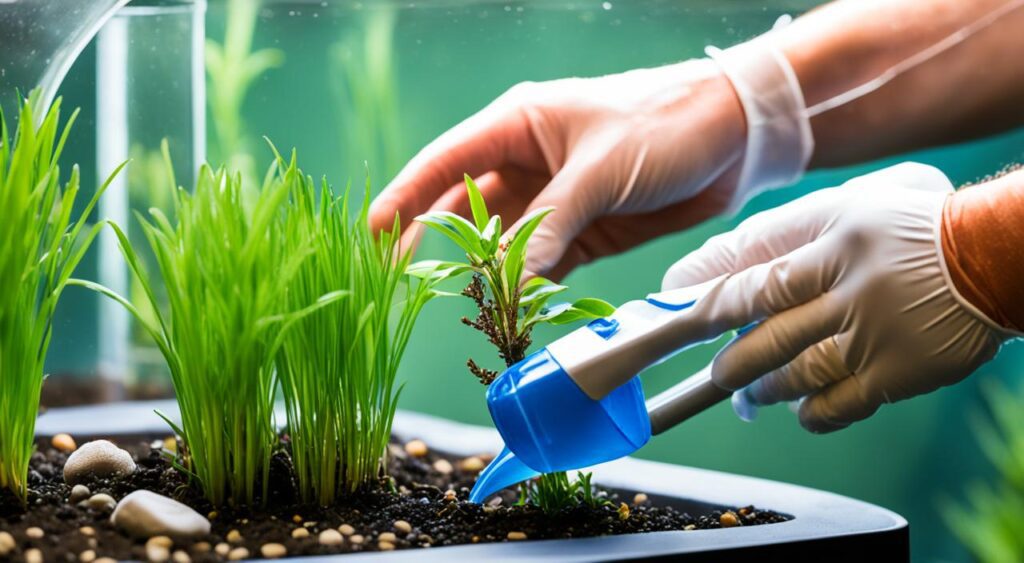
This section will provide step-by-step instructions on how to plant Dwarf Sagittaria in your aquarium. We will discuss the best techniques for proper placement, spacing, and positioning to achieve an attractive and aesthetically pleasing aquatic carpet.
Understanding the root development of Dwarf Sagittaria is essential for its successful growth and establishment in the aquarium. This section will explore the root system of this plant, including its anchoring capabilities and nutrient absorption.
Here, we will discuss the various methods of propagating Dwarf Sagittaria. From division to the use of runners, we will provide detailed guidance on how to effectively propagate this plant and expand its presence in your aquascape.
In this section, we will share expert tips and tricks for maximizing the growth and overall health of Dwarf Sagittaria. From pruning techniques to proper maintenance, these tips will ensure your plant thrives and flourishes in your aquarium.
Care and Maintenance
Routine Care
Proper care and maintenance are crucial for keeping Dwarf Sagittaria healthy and vibrant in your aquarium. Regular tasks such as water changes, trimming, and nutrient supplementation play a vital role in promoting optimal growth and maintaining the overall health of this plant. Regularly, water changes should be done to ensure a stable and healthy aquatic environment. Trimming helps control the growth and prevents the plant from becoming too dense, blocking light and hindering nutrient uptake. Nutrient supplementation, such as adding liquid fertilizers or root tabs, provides essential nutrients that may be lacking in the aquarium water, allowing the plant to thrive.
Nutrient Deficiencies
Dwarf Sagittaria may experience nutrient deficiencies if its nutritional requirements are not met. Understanding the signs of nutrient deficiencies is essential to address them effectively. Common nutrient deficiencies in Dwarf Sagittaria include yellowing or pale leaves, stunted growth, and weakened overall appearance. Consider adjusting the lighting, water parameters, and nutrient supplementation to address nutrient deficiencies. A balanced fertilizer with essential nutrients will help ensure the plant’s proper nutrition and encourage healthy growth in foliage.
Pests and Diseases
While Dwarf Sagittaria is generally a hardy plant, it is still susceptible to pests and diseases that can affect its health. Common issues may arise include algae overgrowth, snail infestations, and specific diseases that can impact the plant’s vitality. To prevent algae overgrowth, maintain proper lighting, limit nutrient imbalances, and ensure regular water changes. Snail infestations can be controlled by manually removing the snails or introducing natural predators like assassin snails. Treatment methods such as using appropriate medications or adjusting water parameters may be necessary if specific diseases are present. Regular monitoring and prompt action are crucial to maintaining the overall health of Dwarf Sagittaria.
Aquascaping with Dwarf Sagittaria
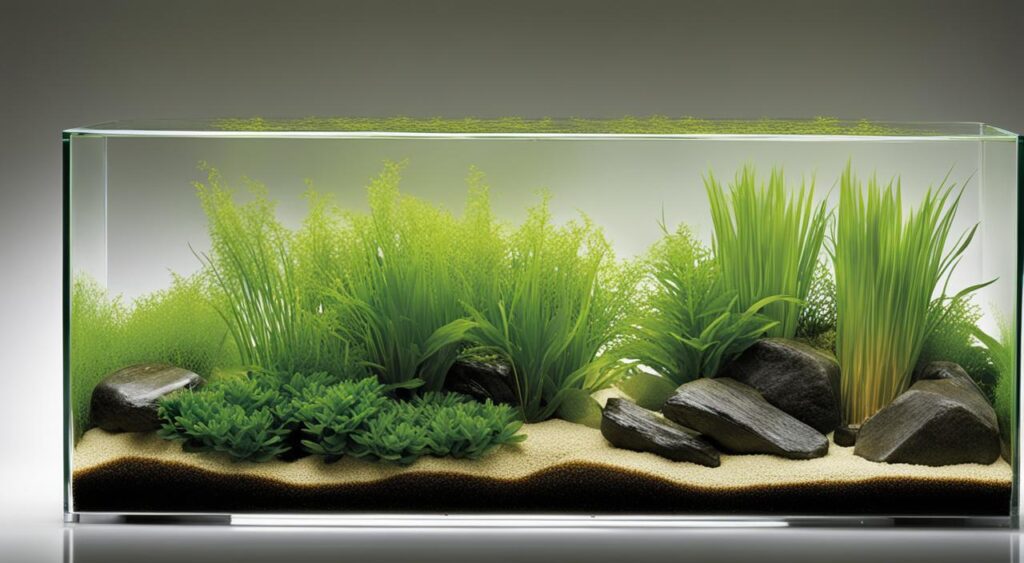
Aquascape Styles
In this section, we will explore different aquascape styles that can incorporate Dwarf Sagittaria as a key element. From minimalistic layouts to lush and intricate designs, we will discuss how this versatile plant can enhance the overall aesthetics of your aquarium.
Companion Plants
Here, we will discuss the best companion plants to pair with Dwarf Sagittaria in an aquascape. We will explore various plant species that complement its visual appeal and growth habits, creating a cohesive and harmonious underwater landscape.
Aquascaping Tips
This section will provide practical tips and insights on how to utilize Dwarf Sagittaria in your aquascape effectively. We will discuss considerations such as foreground placement, spacing, and creating visual depth to achieve a captivating and well-balanced layout.
| Aquascape Style | Companion Plants | Aquascaping Tips |
|---|---|---|
| Minimalistic | Java Moss, Anubias Nana, Micro Sword | Incorporate contrasting textures and heights, creating a sense of depth with the strategic placement of Dwarf Sagittaria. |
| Nature-inspired | Water Wisteria, Amazon Sword, Java Fern | Incorporate contrasting textures and heights, create a sense of depth with strategic placement of Dwarf Sagittaria. |
| Iwagumi | Eleocharis Parvula, Cryptocoryne Wendtii, Blyxa Japonica | Emphasize clean lines and open spaces, use Dwarf Sagittaria to create a focal point or accentuate rock formations |
Benefits of the Aquarium
In this section, we will discuss the positive impact of Dwarf Sagittaria on water quality in the aquarium. We will explore its ability to absorb excess nutrients, provide oxygenation, and improve overall water clarity, creating a healthier environment for aquatic inhabitants.
Water Quality
Dwarf Sagittaria plays a crucial role in maintaining water quality in the aquarium. This plant can absorb excess nutrients, such as nitrates and phosphates, which can lead to algae growth. By removing these excess nutrients, Dwarf Sagittaria helps to prevent algae outbreaks and promotes a clean and healthy aquatic ecosystem.
Shelter and Security
In addition to its water-cleansing abilities, Dwarf Sagittaria also serves as a source of shelter and security for fish and invertebrates in the aquarium. The dense growth habit of this plant provides hiding spots and breeding areas for various species, creating a natural and secure environment. Fish and invertebrates can seek refuge among the dense foliage, reducing stress and promoting overall well-being.
Aesthetic Benefits
Beyond its functional benefits, Dwarf Sagittaria adds aesthetic beauty to the aquarium. This plant can create a lush carpet, adding a vibrant and visually appealing element to the aquascape. The vibrant green colour and slender leaves of Dwarf Sagittaria create a sense of depth, adding visual interest and enhancing the overall aesthetics of the aquarium. The lush carpet of this plant also helps to develop a sense of scale and proportion, complementing other elements in the aquascape and creating a balanced and harmonious overall design.
Challenges and Solutions
Common Challenges
This section will address the common challenges and potential issues aquarists may face when cultivating Dwarf Sagittaria. From algae outbreaks to nutrient imbalances, we will discuss these challenges and provide practical solutions to overcome them.
Solutions
This section will provide detailed solutions and troubleshooting tips for the challenges discussed earlier. These solutions will empower aquarists to proactively address problems and maintain a healthy and thriving Dwarf Sagittaria in their aquarium.
Conclusion
Recap
In this final section, I will recap the essential points discussed throughout the article, summarizing the key aspects of Dwarf Sagittaria care and cultivation. We have explored the fascinating world of Dwarf Sagittaria, also known as Sagittaria subulata, and discovered the critical details about its care requirements, planting techniques, and more.
We have discussed its morphological characteristics, including its leaf structure, size, and colour variations. Understanding its habitat requirements, such as water parameters, substrate, lighting, and CO2 and nutrient supplementation, is crucial for successful cultivation.
We have also explored how to plant and propagate Dwarf Sagittaria, providing step-by-step instructions and growth tips. Additionally, we have discussed care and maintenance practices, common challenges, and solutions.
Recommendations
For aquarists interested in incorporating Dwarf Sagittaria into their aquarium, I recommend considering suitable tank mates that complement its visual appeal and growth habits. Creating an aquascape design incorporating Dwarf Sagittaria as a critical element can enhance the overall aesthetics of your aquarium.
Routine care, including water changes, trimming, and nutrient supplementation, is essential to keep Dwarf Sagittaria healthy and vibrant. Monitoring and addressing nutrient deficiencies and preventing and treating pests and diseases will improve its well-being.
By following these recommendations and incorporating the knowledge gained from this article, aquarists can optimize the growth and overall health of Dwarf Sagittaria, creating a beautiful and thriving freshwater aquarium.
FAQ
What are the care requirements for Dwarf Sagittaria (Sagittaria subulata)?
Dwarf Sagittaria is a relatively low-maintenance aquatic plant. It prefers water temperatures between 68-82°F, pH levels between 6.0-7.5, and moderate to high lighting intensity. Additionally, it thrives in nutrient-rich substrates and benefits from the supplementation of carbon dioxide (CO2) and essential nutrients.
How should I plant Dwarf Sagittaria in my aquarium?
To plant Dwarf Sagittaria, carefully insert the root system into the substrate, making sure to position each individual plant with adequate spacing. It is recommended to plant in a grid-like pattern for optimal coverage. Provide proper lighting, nutrient supplementation, and regular maintenance for successful growth.
How does Dwarf Sagittaria propagate?
Dwarf Sagittaria can be propagated through various methods, including division and the use of runners. To divide the plant, carefully separate the clumps, making sure each portion has an intact root system. Runners can be encouraged and guided to grow in desired areas, allowing the plant to spread naturally.
What are some common challenges when cultivating Dwarf Sagittaria?
Common challenges when cultivating Dwarf Sagittaria include algae outbreaks, nutrient imbalances, and potential pests or diseases. These challenges can be mitigated through proper tank maintenance, water quality management, and prompt action when issues arise.
How can Dwarf Sagittaria enhance my aquascape?
Dwarf Sagittaria serves as a beautiful foreground plant and carpeting plant in aquascapes. Its lush growth and vibrant green color provide visual interest, depth, and scale to the overall layout. Additionally, it offers shelter for fish and invertebrates and helps maintain water quality by absorbing excess nutrients.

